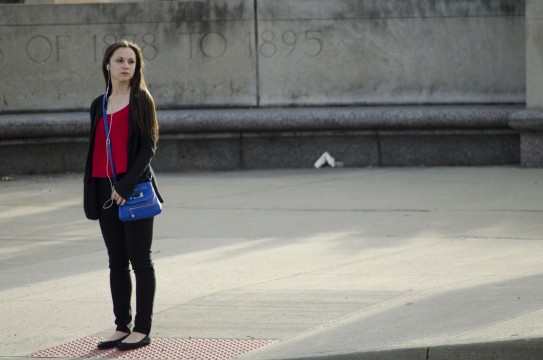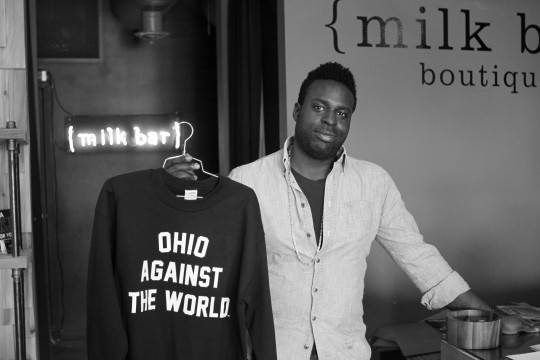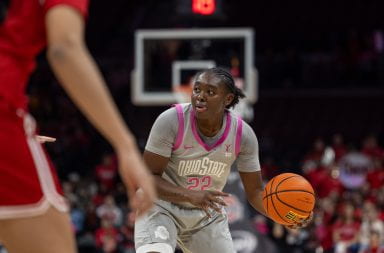Caution tape and construction sites bordering High Street shows the ever-changing landscape along one of Columbus’ main stretches. One art exhibit, though, is putting a temporary pause on the progress.
That “hallway” is High Street, and “25 ON HIGH: A Photographic Journey” is an upcoming exhibit at the Urban Arts Space that documents the faces, landmarks and overlooked affairs of the street, according to the press release.
The pictures in the show range from images of rural farmers and food markets to photos of university students and the hustle and bustle of downtown Columbus.
The exhibit is an update on the documentary “High Street,” a WOSU TV production released in 1974 that collaborated with the now-defunct Department of Photography and Cinema. The same professor who worked on the documentary has brought it back for 2014.
Clayton Lowe, associate professor emeritus of the Department of Theatre, said 2014 represents two anniversaries for him.
“This marks the 40th anniversary of two important events that I didn’t realize,” he said. “Forty years ago in the spring, I produced and was one of the photographers for the ‘High Street’ documentary at WOSU TV. I also became chair of the Department of Photography and Cinema.”
WOSU TV producer Mary Rathke, who discovered Lowe’s photos while working on the station’s documentary “Columbus Neighborhoods: University District,” said the exhibit opening on Lowe’s 40th anniversaries was coincidental.
“I tend (to) think there is something bigger working in the universe, and this is just one of those pleasant things,” she said in an email.
Rathke, a graduate of the Department of Photography and Cinema, approached Lowe with the idea to revisit his documentary for present day.
“I thought that if we put all of the photos in order by address, we could rebuild High Street the way it was in 1973,” she said. “From there, I came up with the idea of rephotographing High Street today, so that not only could we move up and down High Street by address in 1973, but also move back and forth in time, seeing the address in 1973 and in 2013.”
Lowe recruited a team of 24 photographers and took photos of High Street over a two-year period, documenting the city’s rural south end to the suburban city of Worthington. High Street was divided into eight zones that the photographers were assigned to document. The culminating 125 photos are set to be featured in the exhibit.
Matt and Nicolette Swift photographed the University District/Columbus North zone. As some of Lowe’s former students, they were asked to join the project in November 2012 and began taking photos as early as December. They said they discovered a sense of isolation that exuded from pedestrians on what is normally perceived as a busy street.
“They’re listening to their MP3s and there’s no dialogue anymore,” said Nicolette Swift, video and photo artist. “It’s much more silent.”
Matt Swift, program coordinator of the OSU Film Studies program, agreed, saying that there was a feeling of isolation.
“Once you start pulling out the camera and trying to get pictures of people and places, you suddenly become very aware of how isolated everybody is,” Matt Swift said. “It seems like a lot of people are just sitting in a chair by themselves drinking a cup of coffee, not really engaged with the rest of the world around them.”
The Swifts’ zone fell between 5th and Hudson streets. They documented the construction project that’s replacing a former Wendy’s restaurant with new luxury apartments that are set to open in 2015. They watched as the basketball courts on North Campus became rumble to be replaced with new dorms for the university’s North Campus Residential District Transformation project, set to by completed by Fall Semester 2016. They also braved a football game on as Saturday night, which they described as “chaotic.”
“It was just a sea of red,” Nicolette Swift said.
Matt Swift said a prevalent theme in the exhibit is diversity, as well as an outlook on class and the line between those who are in poverty and those who are not.
“One of my photographs was a guy on High Street with a sign that said, ‘I’m just being honest, I just need booze,’” he said. “But then there’s other images of college girls holding hands, dressed up in funny outfits from the night before going clubbing. There’s this weird dynamic between the classes that’s happening in the show.”
Nicolette Swift has five photos in the exhibit and Matt Swift three.
Tracy Turner, a local Columbus writer and former student of Lowe, felt that she wasn’t a photographer, even though she has worked with photographers throughout her career. Lowe still encouraged Turner to take photographs for the exhibit, and she began to notice things that people overlooked.
“I traveled the whole length (of High Street) a few times because I’m writing about the different zones on High Street that will be going in the exhibition, so one thing I learned was … how differently you see things,” she said.
Turner, who has three photos in the exhibit, also wrote eight “meditations” for the exhibit, narratives that represent each zone of High Street and can be read at the beginning of each zone.
Lowe and Turner want to start a conversation about High Street and the perceptions students have about the area’s changes.
“I think it would be beautiful for people to keep looking at High Street and to think about the space that they walk through every day differently,” she said.
Describing the exhibit as a “High Street time capsule,” Lowe encourages students to take photos and take notice of the changes happening around them.
“This is your public street. How do you feel about it? We want to ask those questions,” Lowe said. “Come down to the exhibit. Talk to us, take pictures of what you see as good and bad. How would you like to see High Street become a good environment?”
Lowe hopes to discuss these questions at the exhibit and believes the exhibit asks a question of its own: “Who controls the neighborhood?”
Matt Swift said he believes the significance of the exhibit is showing the importance of street photography in an era of social media.
“One thing that I know is important to Clay specifically is that he’s really going back to the classic street photography, which really isn’t celebrated anymore,” he said. “Expect to go back and basically be in a journey through the still image of High Street, what it is now and what it won’t ever be again.”
“25 on High” is set to open Saturday. A public reception will be held on Sept. 25 from 6:30-8 p.m. Three events are also planned in conjunction with the exhibit during its run:
“Paging Columbus: Readings on High,” which will feature literature about High Street and urban life, is scheduled for Oct. 9 from 6-8 p.m. at the Urban Arts Space.
“Columbus Coalition for the Homeless: A View from the Street” is a panel set to be held Oct. 25 from 1-3 p.m.
“The Masters of Street Photography,” a gallery presentation, will be held on Oct. 30 from 6-8 p.m.







